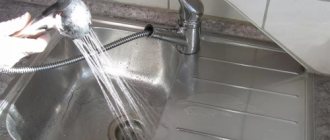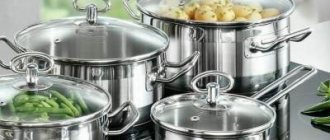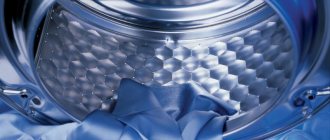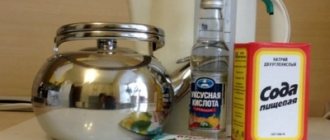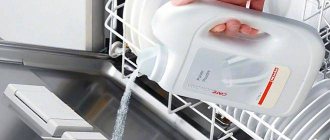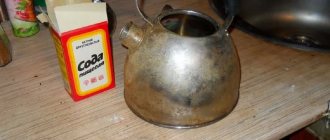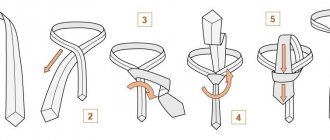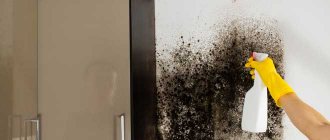Plasma polishing
The technology differs from the electrochemical procedure in the following parameters:
- the solution is not aggressive, disposal does not require special cleaning;
- voltage is higher (220 V);
- temperature is about 100 °C.
The reagent used is ammonium salt with a concentration in the solution of 3.1 ÷ 6.0%. The electric current density is set at 0.35 ± 0.15 A/cm²; gas bubbles are intensively formed in the contact zone of the electrolyte with the stainless steel. Discharges occur in the vapor inside the fluidized bed, ionizing the medium. Plasma tongues appear that specifically act on the steel, polishing it. The time required for one dive is within 6 minutes, based on a power consumption of 5 Wh/cm².
https://youtube.com/watch?v=ClenZE-jiLo
Unscrupulous mechanical preparation will be evident. Residual traces of welds, scratches, and dents cannot be hidden with polish.
Methods for polishing stainless steel
Stainless steel polishing can be done at home. In this case, several processing methods are used. Common methods include:
- mechanical;
- electrochemical;
- electrolyte-plasma.
Mechanical restoration
Polishing of stainless steel is carried out using a material represented by grains of abrasive material. When processing, a circle, disk, roller or tape is used. Various pastes, solutions and suspensions for polishing act as abrasives. The material may contain substances that, in combination with abrasive grains, remove irregularities on metal surfaces. This type of processing is called mechanical.
As a result of mechanical impacts on the metal surface, grooves and stripes with roughness up to class 7 are formed. In this case, additional refinement of stainless steel to class 10 by grinding is necessary.
Refinement of stainless steel can be done at home without the use of special devices and tools. This type of polishing is common in private workshops and garages. In industrial enterprises, the following types of tools are used:
- manual devices with electric and pneumatic drive;
- polishing and grinding machines;
- drum and vibration units;
- installations for processing using magnetic abrasive.
The following abrasive materials are used for fine grinding:
- liquid polish;
- pasta;
- suspension.
They contain mineral oils, paraffin and stearin additives as a base; they must be removed after processing with solvents.
Electrochemical method
Chemical polishing is the process of removing roughness using the ordered movement of charged particles from one electrode to another. The method uses installations with baths filled with an electrolyte solution. One of the electrodes is connected to the negative pole of the power source. The immersed stainless metal workpiece is connected to the positive terminal of the power source.
When direct current is applied, charged ions begin to form on the metal surface, which then flow to the cathode. When stainless steel particles are released, the microprotrusions are smoothed out. During processing, the operator can set the depth of metal removal by adjusting the constant current value, as well as the process time.
The method allows you to polish parts with complex geometric surfaces. Uneven areas are removed from difficult to access areas. The electrolyte has a temperature of up to 90°C, a current density of 0.5 A/cm2, and contains inorganic acids: phosphoric acid and sulfuric acid.
Electrolytic plasma polishing
The method is based on the formation of a jacket on top of the part, which is a vapor-gas plasma. This allows you to remove irregularities from the metal surface. Apparatuses for polishing stainless steel at home operate on an alternating current network at a voltage of 400 V and an electrolyte solution temperature of 90°C. The rate of metal layer removal is up to 3 microns per minute.
The advantages of this method include:
- use of safe substances;
- minimum costs.
Recommendations for caring for bronze and stainless steel items
When cleaning bronze and stainless steel, it is necessary to provide for the possibility of preserving the renewed state. The fact is that after removing the plaque with reagents, an invisible oxidation reaction begins to occur in the upper layer, destroying the metal.
After cleaning, bronze products require protective surface treatment. For these purposes, compositions of natural origin based on natural wax are used.
As for stainless steel, to preserve its original appearance, experts do not recommend washing things in the dishwasher. For daily cleaning of food debris, it is better to use a regular sponge in combination with a suitable detergent. Do not use cleaning abrasives, sponges or metal scourers. Their use leads to the formation of scratches and loss of the characteristic shine of the dishes.
Useful tips
In addition to the techniques and methods discussed above, the following recommendations may also be useful:
- Tarnishing of bronze can be easily removed by applying pre-cooked peas and brought to a paste state to the surface. The liquid mixture must dry completely, after which the product is washed in boiling water and wiped with a damp cloth.
- You can restore the natural appearance of bronze objects with toothpaste applied to flannel or suede. After processing, rinse the item with water and dry.
- Ammonia and mustard powder can be used to clean bronze from plaque.
- Coffee grounds are used to restore the characteristic shine of stainless steel.
In conclusion, we note that the procedure for using these funds is similar to the methods discussed earlier
Please note that the listed methods and approaches for cleaning stainless steel and bronze are based on effective time-tested traditions
Loading …
Responsibility requires work to give the original appearance to expensive bronze art products. The technology requires restoring their characteristic shade. Only in this case will a bronze figurine or other object become a spectacular addition to the interior or shine at exhibitions.
Manual polishing
In the past, craftsmen from all over the world did not have specialized equipment, but they performed their work efficiently. But how to polish a knife without special equipment? After heat treatment, craftsmen used natural abrasive materials (such as stone or a metal device).
Polishing by hand helps achieve a perfectly smooth surface. In this way you can get the correct shape of the blade. Even using a special polishing and grinding device, it is not always possible to achieve a similar effect. It is believed that hand polishing is the final finishing of a knife.
How to polish a knife at home correctly using the manual method? Before proceeding to manual processing, it is necessary to polish the knife on a tape, the grit of which should not be less than 320. Using sandpaper, scratches are first removed. They may appear on the surface of the product after machine processing.
Cleaning the hood
This is not an easy task. But quite doable. To prevent dirt and soap from staining the stove, it is better to cover it with newspapers or old towels.
To clean the hood, you can use a specialized product or prepare a solution yourself. You will need bicarbonate of soda, lemon juice and water. The product must be rubbed in carefully so as not to damage the surface. It is enough for the solution to remain on the hood for several minutes, after which it must be washed off with clean running water. Next, you need to polish the surface well with a dry cloth. After this procedure, the hood will shine like new.
Polishing stainless steel to a mirror shine with your own hands
In the modern world, we regularly come across stainless steel objects, because they have become a part of our lives. These are interior elements on the street and at home, various fences, and a variety of utensils in the kitchen. In this article you will find the answer to the question: how to polish stainless steel, because even such a durable metal can lose its original appearance under the influence of various factors.
What is household stainless steel?
Corrosion-resistant steel or, as it is also called, stainless steel is an alloy of iron and carbon with an admixture of special elements. Steel acquires high resistance to negative environmental factors thanks to these elements. The main one is chromium.
Its percentage in the metal may vary, but not less than 10.5%. Products made from steel with 18% chromium content acquire very high strength, but it is difficult to process such an alloy technologically.
Therefore, in everyday life, steel with an optimal chromium content of 13% is mainly used.
Important! Products made from such stainless steel are characterized not only by durability and the possibility of long-term use, but also by an attractive appearance with a mirror surface. Due to the sufficient chromium content, an oxide film is formed on the metal surface, which protects the stainless steel from corrosion
But still, humid air and other factors can negatively affect the condition of the alloy over time.
Due to the sufficient chromium content, an oxide film is formed on the metal surface, which protects the stainless steel from corrosion. But still, humid air and other factors can negatively affect the condition of the alloy over time.
Important! Having noticed the first signs of corrosion in the form of cloudiness or tarnishing, it is necessary to polish the metal. If there is a need to polish the metal, then there are two possible actions:
If there is a need to polish metal, then there are two possible actions.
Option #1. Specialized assistance
Nowadays, many specialized companies provide high-quality polishing services for stainless steel products. If you do not have the time and opportunity to polish the metal yourself, then contact one of these companies that will give your product a second life.
Option #2. Polishing at home
At home, you can also get a polished, shiny and perfectly smooth stainless steel surface. To do this, there are several ways that will help restore the product to its impeccable appearance. Let's look at what you can use to polish stainless steel.
Video
To familiarize yourself with the nuances of cleaning stainless steel items, watch the following videos:
Young mother, wife and part-time freelancer. Being a lawyer by training, I am accustomed to collecting and providing the most complete and reliable information. Constantly improves in the professional field and strives for personal growth and development.
Found a mistake? Select the text with the mouse and click:
The dishwasher cleans more than just plates and cups. You can load it with plastic toys, glass lamp shades and even dirty vegetables, such as potatoes, but only without using detergents.
Stretch ceilings made of PVC film can withstand from 70 to 120 liters of water per 1 m2 of their area (depending on the size of the ceiling, the degree of its tension and the quality of the film). So you don’t have to worry about leaks from neighbors above.
There are special traps to combat moths. The sticky layer with which they are covered contains female pheromones that attract males. By sticking to the trap, they are eliminated from the reproduction process, which leads to a decrease in the moth population.
Threads made of gold and silver, which were used to embroider clothes in the old days, are called gimp. To obtain them, the metal wire was pulled for a long time with pliers to the required fineness. This is where the expression “to drag out the rigmarole” came from - “to do long, monotonous work” or “to delay the completion of a task.”
If your favorite things show the first signs of gestation in the form of untidy pellets, you can get rid of them using a special machine - a shaver. It quickly and effectively shaves off clumps of fabric fibers and returns things to their proper appearance.
The easiest way to remove scale and carbon deposits from the soleplate of the iron is with table salt. Pour a thick layer of salt onto the paper, heat the iron to maximum and run the iron over the salt bed several times, applying light pressure.
Before removing various stains from clothing, you need to find out how safe the selected solvent is for the fabric itself. It is applied in a small amount to an inconspicuous area of the item from the inside out for 5-10 minutes. If the material retains its structure and color, you can move on to stains.
Fresh lemon is not only suitable for tea: clean dirt from the surface of an acrylic bath by rubbing with half a cut citrus, or quickly wash the microwave by placing a container of water and lemon slices in it for 8-10 minutes at maximum power. The softened dirt can simply be wiped off with a sponge.
The habit of using an automatic washing machine “sparingly” can lead to the appearance of an unpleasant odor in it. Washing at temperatures below 60℃ and short rinses allow fungi and bacteria from dirty clothes to remain on internal surfaces and actively multiply.
How to polish stainless steel | Do it yourself
admin · 01/20/2017
A smooth mirror surface of a stainless part can be obtained not only in a factory; polishing stainless steel is absolutely permissible at home. This process is needed to give a spectacular look to homemade work, to clean up welding seams, or to neutralize scratches on the surface.
You will need
- — angle grinder (grinder);
- — grinding wheels of different grain sizes;
- - sandpaper or stone;
- - wood glue;
- - felt or felt circles;
- - polishing paste.
Instructions
1. First, carry out a rough cleaning of the surface, remove beads of metal from the weld. To do this, use an angle grinder (grinder) and a fiber-based wheel with P60 grain. If the surface is fairly smooth, skip this step.
2. In order to remove risks from P60 grain, take a wheel with P120 grain. If you don't have a wheel with any grit size, make one regardless. To do this, take a felt or felt circle, evenly apply wood glue to it using a spatula and carefully walk it over the abrasive crumbs. Abrasive chips can be obtained from sandpaper or stone by rubbing them against each other.
3. Sand the surface of the stainless steel several more times, each time cutting the size of the abrasive in half. Remember to rinse the stainless steel surface after all sanding. If possible, do not set your angle grinder to a speed greater than 4500 cycles per minute.
4. Check that the surface after sanding should be perfectly smooth. Make sure that all rough roughness is removed; however, after polishing, these areas will have to be sanded again.
5. Take a clean felt or felt circle and polishing paste. The main thing is to choose the right polishing paste, since different types of paste are suitable for different brands. Try to find a diamond paste whose grain size matches your metal; in extreme cases, ordinary polishing paste or GOI will do.
6. Begin finishing polishing the stainless steel, gradually removing visible marks. Little by little, after a while, you will see that the surface becomes more and more smooth, this is due to the fact that under the influence of high temperature the surface of the part melts and spreads. Be careful not to overheat the part; this may cause some metals to change color.
Tip 2: How to Polish Metal
We use a large number of metal objects every day. These can be either cutlery or tools for repairing something. Metal has the ability to oxidize. Its surface begins to become cloudy, and over time, corrosion begins and rust occurs. Therefore, metal objects require periodic polishing.
You will need
Polishing paste, old toothbrush, polishing wheels, old sewing machine motor, GOI paste.
Tip 3: How to polish a stone
Polishing is the final process in stone processing, as a result of which its surface acquires a mirror-like shine, revealing the pattern, color and structure of the rock. As usual, the stone is polished with special devices and in several stages.
Traditional methods for removing plaque and stains from the sink
When a regular washing gel cannot cope with stains, you can use improvised means that you can always find at home or in the store. If you don't clean your sink daily, you'll end up dealing with dark stains, limescale, and greasy residue. Using folk recipes will help clean your sink and prevent serious contamination.
Removing black stains from a stainless steel sink
No matter how well the surface of the sink is cared for, over time the metal begins to darken and black spots appear on it. It's all about food oxidizing agents.
To clean the surface of the sink from blackness, you will need:
Soda and starch. Apply the mixture of the two components to a damp sponge and clean the darkened areas of the sink. At the end of the procedure, rinse everything thoroughly with water.
Household bleach
It easily copes with dark plaque, but you need to treat stainless steel with this composition with caution to avoid white spots. “Whiteness” will do, but dilute it with water before use.
Dentifrice
It can be applied to an unusable toothbrush and whitens hard-to-reach and ridged areas of the sink.
All components for recipes can be easily purchased at your local store, and creating the required solution will take 3-5 minutes.
Cleaning limescale on a sink
White plaque is formed due to daily contact of water with the surface. To prevent limescale, you need to ensure that the tap is sealed and wipe the sink dry after each use.
If plaque has already appeared, folk remedies will help:
- Vinegar. Dilute the acid with water one to one. The solution will not only remove plaque, but also add shine.
- Lemon acid. Fill a sink with warm water and add the contents of one sachet of citric acid. Leave the resulting mixture for 1-2 hours. Rub the problem areas with a nylon sponge, then drain the liquid and rinse the sink with water. A highly concentrated solution of citric acid can contribute to the appearance of dark spots.
- Soda. Sprinkle the surface of the sink and rub problem areas, rinse with water. Repeat the procedure several times, depending on the degree of contamination.
- Dry mustard. Rub the areas sprinkled with powder with a nylon washcloth, then rinse thoroughly. Mustard copes well with limescale and eliminates unpleasant odors from food waste.
- Paste for cleaning ovens. Apply to contaminated areas and treat with a soft washcloth, then rinse with running water.
Folk remedies are non-toxic and safe for the sink itself and for others. If there are small children in the family, such cleaners will not harm their health.
Removing greasy deposits from the sink
Cleaning gel for washing dishes helps to cope with this problem well. But if you don’t have this on hand, you can use laundry soap or make a mixture of soda and office glue yourself. The recipe is simple:
- Mix 5 liters of boiled water, 100 g of soda and 100 ml of glue. The components must be completely dissolved.
- Close the hole in the sink and fill it with the prepared solution.
- Wait for the liquid to cool and drain it.
- Remove grease and dirt. This will be easy because they will soften and move away from the walls.
The effective remedy is prepared in 5-7 minutes and does not require special skills. The result will be visible after the first use, and daily use of the solution will help protect the sink from greasy deposits.
Eliminating unpleasant odor from the sink
Cleaning the sink surface does not always help get rid of an unpleasant odor. It usually comes from food waste and can be felt straight from the drain. Household chemicals will help here. Sanfor, Mole and similar preparations will remove deposits on the walls, and with them the smell will disappear.
If the drain is made of plastic pipes, aggressive substances can damage the integrity of the structure. In this case, you can use folk remedies:
Salt. For 1 l. Warm water will require 5 tbsp. l. Pour the resulting solution into the hole in the sink, after 1-1.5 hours, rinse everything.
After the procedures have been completed, the unpleasant odor will disappear, as will all blockages that prevented the rapid passage of water through the drain.
If the pipes in the apartment are made of metal, household chemicals will deal with the blockage faster than traditional methods.
Methods for polishing stainless steel
Stainless steel polishing can be done at home. In this case, several processing methods are used. Common methods include:
- mechanical;
- electrochemical;
- electrolyte-plasma.
Mechanical restoration
Polishing of stainless steel is carried out using a material represented by grains of abrasive material. When processing, a circle, disk, roller or tape is used. Various pastes, solutions and suspensions for polishing act as abrasives. The material may contain substances that, in combination with abrasive grains, remove irregularities on metal surfaces. This type of processing is called mechanical.
As a result of mechanical impacts on the metal surface, grooves and stripes with roughness up to class 7 are formed. In this case, additional refinement of stainless steel to class 10 by grinding is necessary.
Refinement of stainless steel can be done at home without the use of special devices and tools. This type of polishing is common in private workshops and garages. In industrial enterprises, the following types of tools are used:
- manual devices with electric and pneumatic drive;
- polishing and grinding machines;
- drum and vibration units;
- installations for processing using magnetic abrasive.
The following abrasive materials are used for fine grinding:
- liquid polish;
- pasta;
- suspension.
They contain mineral oils, paraffin and stearin additives as a base; they must be removed after processing with solvents.
Electrochemical method
Chemical polishing is the process of removing roughness using the ordered movement of charged particles from one electrode to another. The method uses installations with baths filled with an electrolyte solution. One of the electrodes is connected to the negative pole of the power source. The immersed stainless metal workpiece is connected to the positive terminal of the power source.
When direct current is applied, charged ions begin to form on the metal surface, which then flow to the cathode. When stainless steel particles are released, the microprotrusions are smoothed out. During processing, the operator can set the depth of metal removal by adjusting the constant current value, as well as the process time.
The method allows you to polish parts with complex geometric surfaces. Uneven areas are removed from difficult to access areas. The electrolyte has a temperature of up to 90°C, a current density of 0.5 A/cm2, and contains inorganic acids: phosphoric acid and sulfuric acid.
Electrolytic plasma polishing
The method is based on the formation of a jacket on top of the part, which is a vapor-gas plasma. This allows you to remove irregularities from the metal surface. Apparatuses for polishing stainless steel at home operate on an alternating current network at a voltage of 400 V and an electrolyte solution temperature of 90°C. The rate of metal layer removal is up to 3 microns per minute.
The advantages of this method include:
- use of safe substances;
- minimum costs.
Polishes
Most work on polishing piece goods and stainless steel metal structures is performed either manually or using a variety of power tools. In this case, a large number of polishing devices are used, among which the most common are:
- napkins, discs and circles made of non-woven fabric, felt and felt;
- rollers and disk packages;
- fan circles;
- polishing abrasive sheets and discs on paper and polymer base;
- non-woven materials with abrasive;
- polishing belts.
Hand-held power tools for polishing stainless steel, in addition to conventional polishing attachments, are equipped with devices for processing hard-to-reach places and curved surfaces. The main types of electrically driven tools used in stainless steel processing are:
- orbital sanders;
- grinders with various attachments and accessories;
- belt sanders;
- straight grinding power tools;
- portable belt sanders;
- band files with rotary attachments.
Various types of pastes are most often used as a polishing material for stainless steel, which are generally divided into materials for rough and final polishing. Based on the composition of their base, they are divided into water and fat. The latter hold abrasive material better, but are more difficult to remove from stainless steel. Auxiliary materials include microfiber cloths, which are used to clean the stainless steel surface after polishing.
Wool polishing pad for polishing from AliExpress from 150 rubles →
Quality characteristics of polished stainless steel pipe
Polished stainless steel pipe with high quality characteristics can be produced exclusively in production conditions with special equipment and instrumentation.
A polished stainless steel pipe that has undergone surface finishing under proper production conditions has a number of important technical and decorative characteristics:
Almost any liquid transported through a pipe - water, milk, acids, alkalis, alcohol, gasoline - does not react with the internal surfaces of the product.
When piping stainless steel polished pipes to boilers and boilers, both of its characteristics are important – utilitarian and decorative. Scale does not form on the internal walls, and the external polished surface blends effectively into the interior of the house.
The decorative capabilities of polished stainless steel pipe allow it to be used inside a building, for exterior facade decoration, and in landscape design. A polished stainless steel pipe is an indispensable attribute of an ultra-modern high-tech style.
Scope of application of polished stainless steel pipes
Since stainless steel pipes are polished, most often, to give the product an attractive appearance, they are usually used for decorative purposes.
In the production of furniture, polished stainless steel pipe is used for the manufacture of frames for chairs, various stands, and arches of mobile tables. Such products are not only aesthetically pleasing, but also strong, durable, retaining their shine for many decades.
Decorative cornices, fences, railings, and awnings are made from polished pipes, which have not only a round, but also any other cross-section. Such products can withstand wind and temperature changes for a long period of time, which are aggravated by contact with abrasive substances - dust and sand.
However, polished pipes perform not only a decorative function, but are also widely used in the food industry.
This is explained by the ideal smooth surface, which does not allow bacteria to accumulate on it, and the absence of a chemical effect of the pipe on the substances transported through it.
All of the above properties of this material make it popular in medicine. In addition to instruments, implants are made from polished stainless steel pipe ,
not rejected by the body due to its chemical stability.
Polished pipes made of corrosion-resistant steel used in water supply and heating systems do not require hidden installation under false panels or suspended ceilings. Polished stainless steel pipes, compared to chrome-plated pipes, are much more resistant to external damage
How to polish steel at home
Stainless steel comes in different varieties. After all, it contains several different metals. The basis of stainless steel is iron, titanium, nickel, molybdenum, manganese, and this is not the entire list. Chromium, which is also present in its composition, helps this steel resist corrosion.
What prevents steel from rusting
When chromium interacts with oxygen, a protective film is formed on the surface of stainless steel; it is this film that protects the alloy from exposure to aggressive environments.
The amount of chromium will determine the degree of corrosion resistance of steel.
For example, in the manufacture of refrigerators, an alloy with an average chromium content (10-17%) is used. But if the device is constantly in contact with water or is subjected to temperature loads, then an alloy with a high chromium content, up to 26%, is used. Such appliances include washing machines, dishwashers, sinks, hoods, cookers and kettles.
Where can I polish?
In order for the surface of the alloy to be beautiful and smooth, you need to polish the stainless steel. Nowadays, there are many companies whose specialization is this particular procedure; they put in order various products made from this alloy. But it turns out that you can polish stainless steel at home.
Of course, if you need better quality work, it is better to seek help from specialists. For example, a polished square stainless steel pipe will look much more impressive after factory processing than after home processing.
Any company that specializes in polishing will easily perform this procedure.
How to process steel
How to polish stainless steel to a mirror shine? Here is a list of everything you will need:
- polishing paste;
- felt or felt circles;
- wood glue;
- grinding wheels with different grain sizes;
- sandpaper or stone;
- Bulgarian.
Main stages of the process
The process takes place in several stages. First you need to do some rough cleaning. Next comes a wheel with a fiber base and an angle grinder. But this procedure can be skipped provided that the surface of the product is already quite smooth.
Grinding wheels come next. The surface must be processed several times, and each time the size of the abrasive should decrease.
If such circles are not available, then you can easily make them yourself. To do this, you can use a felt circle or felt. You need to apply wood glue to it with a spatula, and then rub it over the abrasive chips.
This operation will make the steel surface perfectly smooth. Under no circumstances should any roughness remain. After all, after polishing it will be much more difficult to seal them.
The next step is to apply polishing paste and a felt wheel. Here it is better to consult a specialist, since a specific brand of alloy requires a specific paste.
Of course, it is best to use diamond, the grit of which is suitable for the metal intended for processing. Final polishing is carried out until there are no visible flaws left.
A polished stainless steel pipe should look just perfect.
Stainless steel in everyday life
No kitchen is complete without stainless steel appliances and interior parts. This is not surprising, since this particular alloy is quite strong and durable, especially since it does not require special care. Stainless steel is often used to make dishes, cutlery and stoves, as this metal has a fairly high thermal conductivity.
But there are also some disadvantages to stainless steel: with regular use, it noticeably tarnishes. The kitchen is losing its shine. To prevent this from happening, it is necessary to periodically polish the stainless steel. There are many different ways to solve this problem. An important point in this procedure is the correct selection of polishing agent for stainless steel.
When cleaning steel products, never use bleach or abrasives. Also, do not use metal sponges or brushes with stiff bristles.
There are several alternative polishing methods.
Olive oil
This method is just for those who are thinking about how to polish stainless steel at home. Tarnished dishes will begin to shine again, like new. All you need is oil and rags, preferably made of soft fabric.
Pollution prevention
Professionals have compiled a whole list of preventive recommendations that will extend the service life. First of all, you should refrain from using hard sponges and brushes, they destroy the protective chrome coating. If you need to remove burnt food or other frozen dirt, you should apply a special product to it and leave it for a while, allowing the stain to become softer. Experts strongly advise soaking stains for at least half an hour, then the cleaning process will be faster and easier.
If you need to clean the stove, grill or grates, you must first remove all excess. This will not only reduce cleaning time, but also create more comfortable conditions for it. In addition, experts recommend removing dirt and grease from stainless steel surfaces as soon as possible.
And, perhaps, the last thing you need to know is that stainless steel does not react well to moisture, so after cleaning the product you need to wipe it dry.
Caring for stainless steel structures is not as difficult as it might seem at first glance. If you follow all the instructions from experts on how to clean a stainless steel smokehouse, you can significantly extend the service life of the products and maintain their attractiveness for many years.
Advantages and disadvantages
Electrochemical polishing has the following advantages:
- It increases the strength of steel and prevents rust from appearing on the metal surface. This type of polishing facilitates the drawing and stamping procedure.
- It is capable of softening the surface of complex and refined parts that have additional holes or cavities with complex patterns.
- Electrochemical polishing allows you to reduce the polishing time of the workpiece surface.
- Due to the high productivity of this type of polishing, the basic structure of the product is not damaged during metal processing.
- Speeds up the polishing process.
Despite the large number of advantages, electrochemical polishing has several disadvantages:
- The complexity of polishing due to the need to prepare an individual solution for processing parts made of different steels and regulating the amount of current supplied.
- It uses electropolishing elements, which leads to increased energy consumption.
- Electrochemical polishing cannot smooth out the surface of a workpiece with large cracks or depressions.
- As with chemical polishing, a person needs to work with toxic substances that harm the body.
- Electrochemical polishing does not require large financial expenses, unlike mechanical polishing, which is due to the purchase of many chemical solutions and a permanent supply of electricity. The electrolyte has a short service life, so it must be periodically renewed, which leads to additional financial costs.
To effectively use electrochemical polishing technology, you need to follow safety precautions: work in special clothing, properly configure technical equipment, and perform polishing only with working devices.
Application area
Electrochemical polishing technology is actively used in industry: for processing fittings, carburetor elements (fuel supply valves made of stainless steel), thin strips, wires and pipe mechanisms.
As a result of polishing, the surface of these parts becomes resistant to corrosion and becomes smoother. Currently, this technology is actively used to remove the defective layer from cutting tools used to make holes. Electrochemical polishing of tungsten began to be actively introduced in the production of electron tubes and electric vacuum equipment.
The use of electrochemical polishing technology is practiced in metallographic studies for the diagnosis of steels. Using this technology, cracks, flakes and other inconsistencies in the structure of metals are detected. If irregularities are detected, polishing is carried out to remove the most subtle deformations.
